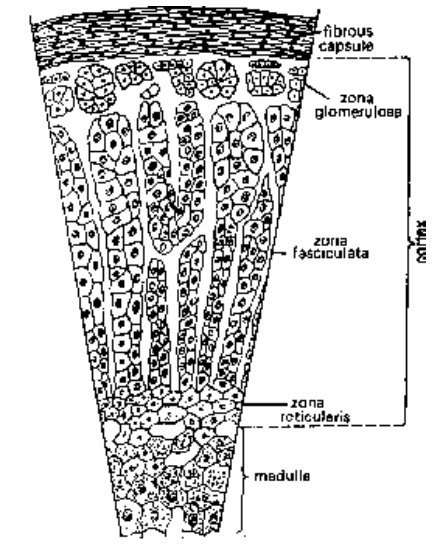
Adrenal (or Suprarenal) Gland
Endocrine System of Class 11
Adrenal (or Suprarenal) Gland
Adrenal gland are paired endocrine glands located superior to kidneys (Ad-Adjacent, Renal - Kidney). In reptiles, birds and mammals these are
located above the kidneys, so are called Suprarenals. In amphibians (frog) adrenal gland is embedded in the kidney so it is called Interrenal.
In certain fishes it is called Head kidney.
It is yellow in colour and size is larger in females than males (wt is 4-5 gms each). It is covered by a fibrous capsule.
It is structurally and functionally divided into an outer adrenal contex (75%) and inner adrenal medulla (25%)
Adrenal cortex develops from mesoderm and adrenal medulla develops from ectoderm.
Adrenal cortex has steroidogenic cells and medulla has chromaffin cells.
Covered by a fibrous connective tissue capsule. The structure is internally differentiated as outer mesodermal cortex and inner ectodermal medulla of nervous origin.
Cortex : It consists of following three layers of cells.
Zona glomerulosa : Outermost layer below the capsule, made of five layers of small cuboidal basophilic cells densely set a long axis parallel to the surface.
Zona fasciculata : Thickest and middle part having large polyhedral cells arranged in radiating columns perpendicular to the surface.
Zona reticularis : The innermost part, having cells arranged in a layer to form network.
Medulla: Consists of groups of round granulated cells which are modified postganglionic cells of sympathetic nervous system having exclusively secretory function. These are chromaffin cells, distinct in
two layers: Adrenal medulla represents essentially an enlarged and specialized sympathetic ganglion and is called a neuroendocrine transducer because a neural signal to this organ evokes hormonal secretion.
Adrenal medulla is the only autonomic neuroeffector organ without a two neuron motor innervation. It is innervated by long sympathetic preganglionic cholinergic neurons that form synaptic connections with the chromaffin cells.
Zona compactum : Densely packed rounded cells with thick plasma membrane, without any intercellular spaces, the average size of cells in 190 - 210 µm (diameter).
Zona spongiosum : The inner most layer of irregular cells in 5-12 layers with large intercellular spaces with matrix and blood vessels, the average size of cells is 260 µm - 360 µm.
Cortical hormones:
About 50 types of steroids have been isolated from adrenal cortex hence called as corticosteroids. But, only few are biologically active. These are synthesized from cholesterol.
1. Mineralocorticoids (Aldosterone)
A 21-carbon steroid molecule is secreted by zona glomerulosa.
Increases the reabsorption of Na+ and Cl– by uriniferous tubules, also controls the level of other salts, thus play role in osmoregulation.

Increases the removal of K+ in urine.
Hypersecretion causes Conn’s disease symptomatized by hypertension (hypernatremia),
muscular weakness (hypokalemia), nervous disorders resulting in death.
Hyposecretion causes hyponatremia (low B.P.) and hyperkalemia.
2. Glucocorticoids (Cortisol or Hydrocortisone and Corticosterone)
A steroid of 20 carbons it is secreted from zona fasciculata and zona reticularis.
75% plasma cortisol is bound to cartisol binding globulin [CBG] or transcortin which is an globulin - 15% is bound to albumin and 10% is unbounded.
It controls metabolism of carbohydrates, proteins and fats, and stimulates gastric secretions.
